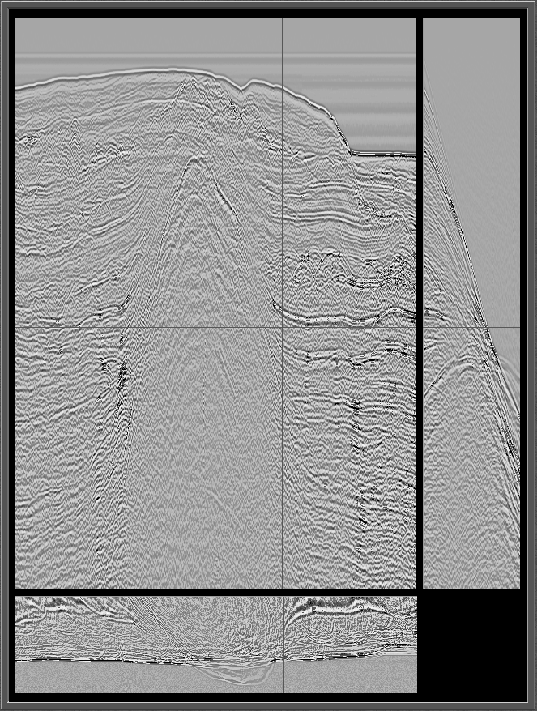




Next: Slicer
Up: MULTI-DIMENSIONAL SEISMIC DATA VISUALIZER
Previous: MULTI-DIMENSIONAL SEISMIC DATA VISUALIZER
The Browser module reads and decimates the data. The data file
can be either on the Scalable Disk Array (SDA) of the CM-5 or on any
file system in the network mounted on the CM partition manager.
In the first case the read operation will
be fast (about 10 Mbytes/s), whereas in the
second case it will run at network speed.
The disk file can span several gigabytes (our SDA capacity is about 17 Gbytes),
but, at any given time, only about 600 Mbytes can be held in memory
and visualized.
To enable the analysis of large datasets the
Browser module provides the capability
of reading from disk only a subset of the data.
The subset to be read into CM memory is selected by using
sliders, as shown in Figure ![[*]](http://sepwww.stanford.edu/latex2html/cross_ref_motif.gif) .
Following conventions adopted in the SEP Window program,
the values of n3 and n4
will determine the lengths of the third and fourth axis of the
subcube to be read in memory. The parameter f3 and f4 determine
the starting points along the third and fourth axis,
and j3 and j4
the sub-sampling rates.
Once the sliders are set on desired values, the button Browser-Enter
is clicked, and the read operation is initiated.
Amoco-salt-disp
.
Following conventions adopted in the SEP Window program,
the values of n3 and n4
will determine the lengths of the third and fourth axis of the
subcube to be read in memory. The parameter f3 and f4 determine
the starting points along the third and fourth axis,
and j3 and j4
the sub-sampling rates.
Once the sliders are set on desired values, the button Browser-Enter
is clicked, and the read operation is initiated.
Amoco-salt-disp
Figure 2 Display of a 3-D prestack marine survey created using the
network shown in Figure ![[*]](http://sepwww.stanford.edu/latex2html/cross_ref_motif.gif) . The three slices show
a common-offset section, a shot gather, and a time slice.
. The three slices show
a common-offset section, a shot gather, and a time slice.
 Input-cont
Input-cont
Figure 3 Control panel for selecting the input data to be read from disk.
The file browser on the left is used for selecting the data file.
The sliders on the right are used for selecting a subset of the dataset
to be read into the CM-5 memory.






Next: Slicer
Up: MULTI-DIMENSIONAL SEISMIC DATA VISUALIZER
Previous: MULTI-DIMENSIONAL SEISMIC DATA VISUALIZER
Stanford Exploration Project
11/16/1997

![[*]](http://sepwww.stanford.edu/latex2html/cross_ref_motif.gif) . The three slices show
a common-offset section, a shot gather, and a time slice.
. The three slices show
a common-offset section, a shot gather, and a time slice.
![[*]](http://sepwww.stanford.edu/latex2html/cross_ref_motif.gif) .
Following conventions adopted in the SEP Window program,
the values of n3 and n4
will determine the lengths of the third and fourth axis of the
subcube to be read in memory. The parameter f3 and f4 determine
the starting points along the third and fourth axis,
and j3 and j4
the sub-sampling rates.
Once the sliders are set on desired values, the button Browser-Enter
is clicked, and the read operation is initiated.
.
Following conventions adopted in the SEP Window program,
the values of n3 and n4
will determine the lengths of the third and fourth axis of the
subcube to be read in memory. The parameter f3 and f4 determine
the starting points along the third and fourth axis,
and j3 and j4
the sub-sampling rates.
Once the sliders are set on desired values, the button Browser-Enter
is clicked, and the read operation is initiated.

![[*]](http://sepwww.stanford.edu/latex2html/cross_ref_motif.gif) . The three slices show
a common-offset section, a shot gather, and a time slice.
. The three slices show
a common-offset section, a shot gather, and a time slice.
